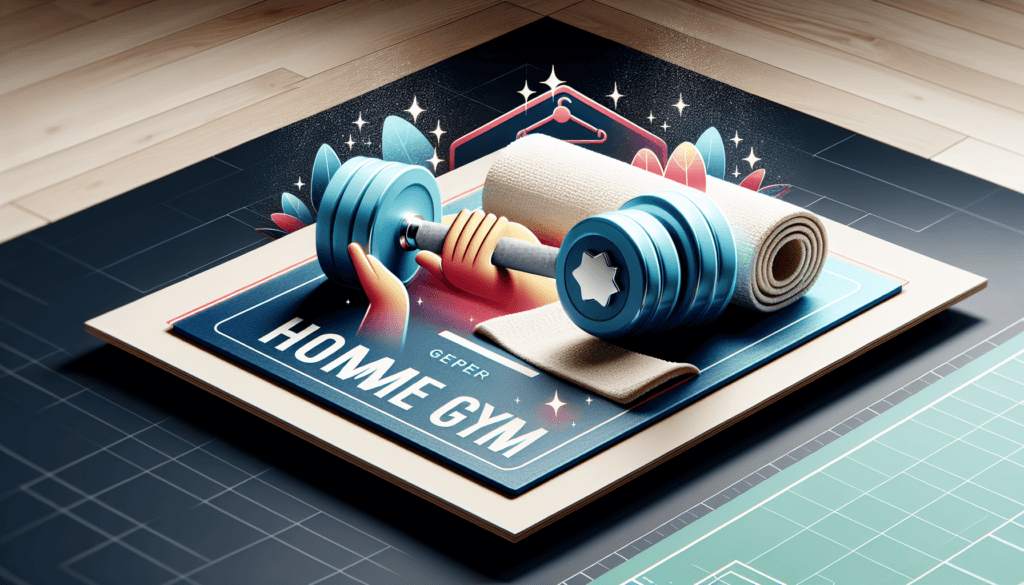Keeping your home gym equipment clean and properly maintained is essential to ensure its longevity and your safety during workouts. In this article, we will walk you through five simple steps that will help you maintain your equipment in top condition, allowing you to enjoy a clean and efficient workout environment in the comfort of your own home. Say goodbye to dust, grime, and the worry of equipment issues, as we guide you step by step towards a well-maintained and sparkling home gym setup.

Regular Cleaning Routine
Keeping your home gym equipment clean is not only important for maintaining its longevity but also for your own health and safety. Establishing a regular cleaning routine will ensure that your equipment stays in top condition and free from germs. By following these simple steps, you can keep your gym equipment clean and sanitized.
Cleaning Supplies
Before you start cleaning, gather all the necessary supplies. You will need cleaning solutions, disinfectants, microfiber cloths, and paper towels. Make sure to choose cleaning products that are safe for use on the specific materials of your equipment. It’s also a good idea to have gloves on hand to protect your skin from any harsh chemicals.
Disinfecting Surfaces
Start by disinfecting all the surfaces of your gym equipment. Germs and bacteria can easily accumulate on handles, seats, and other high-touch areas. Take a disinfectant wipe or spray and thoroughly clean these surfaces. Make sure to follow the instructions on the cleaning product to ensure effective disinfection.
Wiping Down Equipment
After disinfecting, use a microfiber cloth or paper towel to wipe down the entire equipment. This will help remove any remaining debris or residue. Pay special attention to areas that are prone to sweat buildup, such as the handles and seats. Regularly wiping down your equipment will not only keep it clean but also prevent any unpleasant odors.
Cleaning Mirrors and Windows
Don’t forget to clean any mirrors or windows in your home gym. Use a glass cleaner and a lint-free cloth to ensure a streak-free shine. Having clean mirrors and windows will not only make your workout space look more inviting but also help you check your form during exercises.
Cleaning Cardio Machines
Cardio machines like treadmills, stationary bikes, elliptical trainers, and rowing machines are commonly found in home gyms. Here’s how you can properly clean each of these machines:
Treadmill
When cleaning a treadmill, start by unplugging it from the power source. Wipe the entire surface of the machine, including the display, handles, and running belt, with a damp cloth. Pay close attention to the areas where sweat may accumulate. Use a vacuum or a handheld brush to remove any dust or debris from the motor cover and the surrounding areas. Finally, wipe down the treadmill with a dry cloth and plug it back in.
Stationary Bike
To clean a stationary bike, begin by wiping down the handlebars, seat, and pedals with a damp cloth. Use a small brush or a toothbrush to clean hard-to-reach areas, such as the crevices around the pedals. Don’t forget to clean the display console and any cup holders or storage compartments. Finish off by drying the bike with a clean cloth.
Elliptical Trainer
When cleaning an elliptical trainer, start by wiping down the handles, foot pedals, and frame with a damp cloth. Use a soft brush to clean any grooves or hard-to-reach areas. Pay attention to the joints and moving parts, as they may accumulate dust and debris. Use a dry cloth to remove any excess moisture and ensure that the machine is completely dry.
Rowing Machine
To clean a rowing machine, wipe down the frame, handles, and seat with a damp cloth. Use a small brush or a toothbrush to clean any crevices or hard-to-reach areas. Pay close attention to the seat and footrest, as they can accumulate sweat and dirt. Make sure to dry the machine thoroughly before using it again.

Cleaning Strength Training Equipment
Strength training equipment, such as dumbbells, weight plates, weight benches, and barbells, also require regular cleaning. Follow these steps to keep your weightlifting equipment in pristine condition:
Dumbbells
To clean dumbbells, wipe them down with a damp cloth or a disinfectant wipe. Pay attention to the grip area, as sweat can build up there. Avoid using abrasive cleaners that may damage the surface of the dumbbells. If your dumbbells have rubber or plastic components, make sure to clean them gently to prevent any deterioration.
Weight Plates
When cleaning weight plates, use a damp cloth or towel to wipe them down. Avoid using excessive water to prevent any moisture from seeping into the plates. If there is any visible grime or dirt, use a mild soap solution to clean the weight plates. Make sure to dry them thoroughly before placing them back on the storage rack.
Weight Bench
To clean a weight bench, remove any cushions or padding and follow the manufacturer’s instructions for cleaning. Most weight benches have removable covers that can be hand-washed or machine-washed. For the metal frame, use a damp cloth or disinfectant wipe to wipe down the surfaces. Make sure to dry all the components before reassembling the weight bench.
Barbells
When cleaning a barbell, use a cloth or towel soaked in warm soapy water to wipe down the entire length of the bar. Pay attention to the knurling, as it can accumulate sweat and debris. Use a small brush or toothbrush to clean any hard-to-reach areas. Rinse the barbell with clean water and dry it thoroughly to prevent any rust or corrosion.
Maintaining Cardio Machines
Regular maintenance of your cardio machines is essential for their proper functioning and longevity. Follow these maintenance tips to ensure that your machines continue to perform at their best:
Lubricating Moving Parts
One important maintenance task for cardio machines is lubricating the moving parts. Check the manufacturer’s instructions for the specific lubricant recommended for your machine. Apply the lubricant to the designated areas, such as the treadmill’s belt or the bicycle’s pedals and chain. Regular lubrication will prevent excessive wear and tear, reduce friction, and extend the life of your machine.
Tightening Bolts and Screws
Over time, the vibrations and movements of cardio machines can loosen bolts and screws. Regularly check all the visible bolts and screws on your machines and tighten them as necessary. This will prevent any excessive movement or wobbling during workouts and ensure your safety while using the equipment.
Checking Belt Tension
For machines with belts, such as treadmills and elliptical trainers, it’s important to check the belt tension regularly. A loose belt can cause slipping or uneven movement, affecting the effectiveness of your workout. Follow the manufacturer’s instructions to adjust the tension of the belt properly. If you’re not sure how to do it, consult a professional or refer to the equipment’s user manual.
Calibrating Sensors
If your cardio machines have built-in sensors, such as heart rate monitors or calorie counters, it’s important to calibrate them periodically. These sensors can lose accuracy over time, affecting the reliability of the data displayed. Follow the manufacturer’s instructions to calibrate the sensors correctly. Calibration will ensure that you’re getting accurate feedback during your workouts.

Maintaining Strength Training Equipment
Proper maintenance of strength training equipment is crucial for both functionality and safety. Here are some tips to keep your weightlifting equipment in optimal condition:
Inspecting Cables and Pulleys
Regularly inspect the cables and pulleys of your strength training equipment for any signs of wear or damage. Check for frayed or worn cables and any misalignment of pulleys. If you notice any issues, contact the manufacturer or a professional to have them repaired or replaced. Regular inspection will prevent accidents and ensure the continued effectiveness of your exercises.
Tightening Hardware
Similar to cardio machines, strength training equipment can also experience loosening of hardware over time. Check all visible bolts, screws, and nuts on your equipment and ensure that they are tightly fastened. Loose hardware can compromise the stability and safety of your workouts. Regularly tightening all the hardware will prevent any unexpected accidents and injuries.
Checking Padding and Upholstery
Inspect the padding and upholstery of your weight benches and other equipment regularly. Look for any tears, cracks, or signs of wear. Damaged padding not only affects the comfort of your exercises but can also pose a safety hazard. If you notice any issues, contact the manufacturer for replacement parts or seek professional help for repairs.
Lubricating Pivot Points
Strength training equipment with pivot points, such as cable machines and multi-gyms, also require regular lubrication. Apply a suitable lubricant to the pivot points to ensure smooth movement and prevent any squeaking or sticking. Check the manufacturer’s recommendations for the type of lubricant to use and apply it according to their instructions. Regular lubrication will prolong the lifespan of your equipment and improve your workout experience.
Hygiene Practices
Maintaining proper hygiene practices while using your home gym equipment is essential for your health and the cleanliness of your workout space. Incorporate these practices into your routine to promote a hygienic environment:
Using a Towel
Always use a towel when using gym equipment. Place a clean towel on a seat or handlebars to prevent direct contact with your sweat. This will not only keep the equipment clean but also help prevent the spread of bacteria and viruses.
Using Wipes
Keep disinfecting wipes handy in your home gym. Before and after using any equipment, wipe down the surfaces thoroughly. Disinfecting wipes are an easy and effective way to kill germs and prevent the spread of illness.
Washing Hands
Wash your hands before and after each workout session. Use soap and warm water, and scrub your hands for at least 20 seconds. Proper hand hygiene is one of the most effective ways to prevent the transmission of germs and viruses.
Using Hand Sanitizer
If soap and water are not readily available, use an alcohol-based hand sanitizer that contains at least 60% alcohol. Apply a generous amount of sanitizer to your hands and rub them together until dry. Hand sanitizer is a convenient alternative when handwashing is not possible.

Proper Storage
Properly storing your gym equipment is essential for maintaining its condition and maximizing its lifespan. Follow these storage tips to keep everything organized and in good shape:
Organizing Equipment
Designate specific areas in your home gym for each piece of equipment. Keep similar items together, such as dumbbells on a rack or weight plates on a storage tree. This will not only make your gym space look neater but also prevent any accidental damage or tripping hazards.
Using Equipment Mats
Consider placing equipment mats underneath heavy equipment, such as cardio machines and weight benches. Mats help protect the floor from any potential damage caused by the equipment’s weight or movement. They also provide a cushioning effect, reducing vibrations and noise during workouts.
Storing Small Accessories
Don’t forget to properly store small accessories, like resistance bands, jump ropes, and exercise balls. Use storage bins, shelves, or hooks to keep these items organized and easily accessible. Storing them properly will prevent clutter and make it easier to find what you need for your workouts.
Avoiding Humidity
Humidity can be detrimental to gym equipment, particularly if it’s exposed to moisture for extended periods. To prevent rust or corrosion, ensure that your gym space has proper ventilation and controlled humidity levels. If necessary, consider using dehumidifiers or fans to maintain an optimal environment for your equipment.
Inspecting Safety Features
Regularly inspecting the safety features of your gym equipment is crucial for your own protection. Follow these tips to ensure that your equipment is in safe working condition:
Checking Emergency Stop
For cardio machines that have emergency stop buttons or straps, test them regularly to ensure they’re working properly. Familiarize yourself with the location and operation of these safety features. In case of any emergency or sudden discomfort, you’ll be prepared to stop the machine quickly and prevent any injuries.
Evaluating Safety Pins
Strength training equipment often includes safety pins or locking mechanisms to secure weights or adjust settings. Inspect these safety features regularly and ensure that they are functioning correctly. Replace any damaged or worn-out pins or locking mechanisms to maintain the stability and safety of your exercises.
Inspecting Handles and Grips
Inspect the handles and grips of your equipment for any signs of wear or damage. Loose or damaged handles can compromise your grip and stability during workouts. If you notice any issues, consider replacing the handles or grips to ensure a secure and comfortable hold.
Testing Resistance Levels
If your equipment has adjustable resistance levels, test them periodically to ensure they are functioning properly. Adjust the resistance level and verify that the machine responds accordingly. This will allow you to maintain consistent and effective workouts without any unexpected changes in resistance.
Troubleshooting Common Issues
While proper maintenance and care can minimize the occurrence of problems, it’s important to be aware of common issues that may arise with your home gym equipment. Here are some troubleshooting tips for addressing these issues:
Strange Noises
If you notice any unusual noises coming from your machines, such as squeaking, grinding, or rattling, it’s essential to identify the source of the problem. Start by checking for loose parts or debris. Lubrication may also help rectify certain noise issues. If the problem persists, consult the user manual or contact the manufacturer for further assistance.
Display Malfunctions
When experiencing display malfunctions, such as inaccurate readings or a blank screen, first ensure that the machine is properly plugged in and turned on. If the issue persists, check the power source and cables for any damage. In some cases, a simple reset or battery replacement may solve the problem. If the display continues to malfunction, consider contacting the manufacturer or seeking professional assistance.
Slipping Belts or Cables
For machines with belts or cables, slipping can affect the effectiveness of your workouts. If you notice slipping, check the tension of the belt or cable and adjust it if necessary. Ensure that the fastening mechanisms are secure and that the belts or cables are not worn or damaged. If the issue persists, consult the manufacturer or a professional for guidance.
Uneven Resistance
Uneven resistance can be a sign of mechanical issues with your equipment. If you encounter inconsistent resistance during your workouts, first check that the weight plates or resistance settings are properly secured. Inspect the pulleys, cables, and mechanisms to ensure smooth movement and even distribution of resistance. If the problem persists, consult a professional to diagnose and address the issue.
Regular Maintenance Schedule
Establishing a regular maintenance schedule is essential for keeping your home gym equipment in optimal condition. Follow these general guidelines for cleaning and maintenance:
Frequency of Cleaning
Clean and disinfect your gym equipment after each use. This will help eliminate any bacteria or viruses and prevent the buildup of sweat and grime. Incorporating cleaning into your post-workout routine will make it a consistent habit.
Monthly Maintenance Tasks
On a monthly basis, perform more thorough cleaning of your equipment. Wipe down all surfaces, including hard-to-reach areas, with a suitable cleaning solution. Inspect all visible parts for any signs of wear or damage. Lubricate the moving parts as recommended by the manufacturer. Performing these tasks monthly will help identify any potential issues before they become major problems.
Quarterly Maintenance Tasks
Every three months, dedicate time to more intensive maintenance tasks. Check all bolts, screws, and nuts for tightness. Inspect cables, pulleys, and belts for signs of wear or damage, and replace them if necessary. Deep clean all upholstery and padding, following the manufacturer’s instructions. Calibrate any sensors or displays as recommended. Quarterly maintenance ensures the ongoing performance of your equipment.
Annual Maintenance Tasks
Once a year, perform a comprehensive maintenance check on your home gym equipment. Disassemble and inspect all removable parts for wear, damage, or corrosion. Lubricate all moving parts as recommended. Test the functionality and safety features of your equipment and address any issues accordingly. Annual maintenance will help extend the lifespan of your equipment and optimize your workout experience.
By following these maintenance and cleaning tips, you can ensure that your home gym equipment remains in top shape and provides you with years of safe and effective workouts. Remember, a clean and well-maintained gym is not only more enjoyable to use but also promotes a healthy and hygienic exercise environment.


